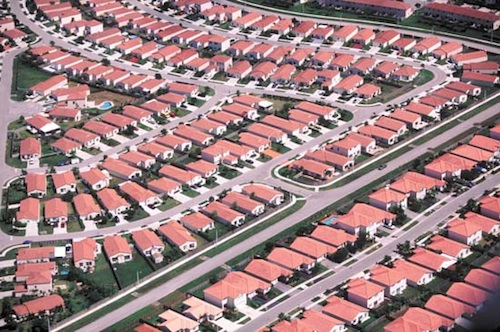Here’s a new report (PDF) from Smart Growth America on the portions of America with the largest (and smallest) amount of sprawl. I’ll break it down for you quickly. The three parts of America with the most sprawl are:
1. Hickory/Lenoir/Morganton (NC)
2. Atlanta/Sandy Springs/Marietta (GA)
3. Clarksville (TN/KY)
The three areas with the least sprawl are:
1. New York City
2. San Francisco
3. Atlantic City
See a pattern here? Of course you do. It’s also outlined here:
The connection between sprawl and conservatism comes through loud and clear in our analysis of more than 200 of America’s metro areas. Our correlations suggest that sprawled America is Red America, while Blue America takes on a much more compact geography. The Sprawl Index was negatively associated with the share of voters in a metro who voted for Mitt Romney in 2012 (with a correlation of -.44); and it was positively associated with the percentage who voted for Barack Obama (.43). These were among the strongest correlations in our analysis.
“There are certain things in which the physical nature of a city, the fact the people are piled on top of each other, requires some notion of the public good,” says Kruse. “Conservative ideology works beautifully in the suburbs, because it makes sense spatially.”
So there you have it, demographically speaking: the most conservative of us are moving to the areas with the most sprawl, and the most liberal of us are moving to cities. This also helps explain Electoral College shifts in favor of the Democrats when you consider that more people now are living in cities.
There are arguments for both sides, of course — where you want to live depends on your specific situation — in that “sprawling” areas tend to give you larger amounts of land/potentially cheaper home prices relative to space, whereas “compact” areas tend to give you a deeper feeling of community and more available without using a car, etc. There’s also a much broader trend line here about GOP candidates not embracing cities during elections, but much has been written about that by people smarter than I, so I’ll mostly skate around that issue.
Hickory, by the way — the No. 1 for sprawl — is also in one of the most conservative Congressional districts in America.
My friend told me a couple of weeks ago that he thinks America is now pretty much just city hubs (i.e. over a million and/or places with a serviceable airport) and exurbs. That’s it. I’m not sure it’s exactly that yet — parts of the Carolinas and the Pacific Northwest still have an “original” feeling to them, as well as the Rockies — but it’s definitely becoming that. It has broad implications for elections, economics, the sociology of families, and much more. For now, take this from The Atlantic Cities:
And perhaps most importantly for those who argue that the benefits of sprawl – including large home sizes and big swathes of land for each family – outweigh the costs, we found a positive association (.21) between compactness and the happiness and well-being of residents. This reinforces the findings of the Smart Growth America report, which found that residents of compact metros tended to live longer, perform better on a number of health and obesity metrics, and have a better chance at true economic mobility. In contrast, those living in sprawling metros tended to spend more on transportation and housing, exercise less, and experience far less social capital in their communities.
Intriguing. Also should be noted that most of the top finishers in the “sprawl” category were in the American Southeast, which is also the worst place for social mobility right now.
